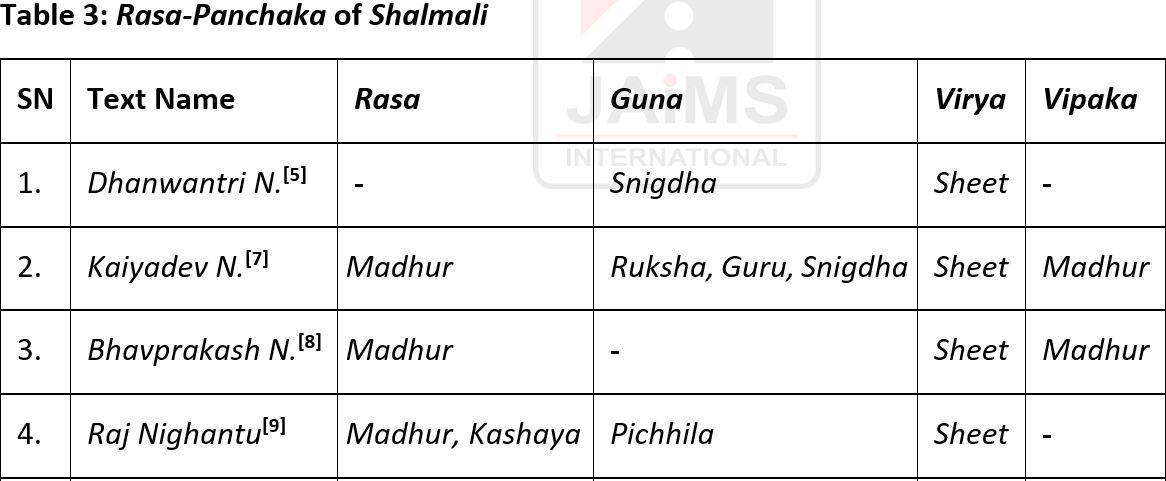Therapeutic Potential of Bombax ceiba Linn. - A Review
DOI:
https://doi.org/10.21760/jaims.10.9.30Keywords:
Shalmali, Mochras, Bombax ceiba, Ayurveda, Pharmacological propertiesAbstract
Shalmali, botanically identified as Bombax ceiba Linn., a robust long-lived tree found abundantly growing across country, has been in the focus of pharmacotherapeutic applications in Ayurveda since time immemorial. Almost every plant part like root, stem bark, leaves, flowers, Gum exudate have been described with different type of pharmacological properties and therapeutic potential in classical texts of Ayurveda to treat a number of diseases. According to Ayurveda, it has stimulant, astringent, hemostatic, aphrodisiac, diuretic, antidiarrheal, emetic, demulcent, anti-dysenteric, and antipyretic properties. Numerous pharmacological properties of the Shalmali have been shown in both in vitro and in vivo research, including analgesic, immunomodulatory, anti-inflammatory, antioxidant, anti-acne, antimicrobial, hypotensive, hypolipidemic, and antihyperglycemic effects. Present review is an attempt to bring forth the pharmaceutical and nutraceutical potential of various plant parts of Shalmali.
Downloads
References
Rai RK., Hindi translation of Vedic index of names and subjects. Vol. II. by Macdonell AA. Varanasi: Chowkhamba Vidyabhawan; 1962. p. 408.
Singh KK. Flora of Dudhwa National Park. Dehradun: Bishen Singh Mahendra Pal Singh; 1996. p. 100.
Sharma M, Sahu S. In: Gallery of Medicinal Plants. New Delhi: Thieme Publishers; 2020. p. 531.
Anonymous. Review on Indian Medicinal Plants. Vol 4. New Delhi: Indian Council of Medical Research; 2008. p. 319.
Ojha J, Mishra U, editors. Dhanvantari Nighantu: Hindi translation and commentary. 1st ed. Varanasi: Adarsh Vidya Niketan; 1985. Amradi Varga. p. 255.
Upadhya RP. Madanpal Nighantu by Acharya Madanpal. Mumbai: Shrikrishna Das Prakashan; 1990. p. 55, 118.
Sharma PV, Sharma GP. Kaiyadeva Nighantuh Pathyaapathya Vibodhakah. 1st ed. Varanasi: Chaukhambha Orientalia; 1979. Aushadhi Varga. p. 168.
Chunekar KC. Bhav Prakash Nighantu: Indian Materia Medica of Sri Bhav Mishra. Reprint ed. Varanasi: Chaukhambha; 2018. Vatadi Varga. p. 525.
Tripathi I, Dravyagunaprakasika Hindi commentary on Raj Nighantu of Narahari P. 1st ed. Varanasi: Chaukhambha Krishnadas Academy; 1982. p. 232.
Vaishya S. Saligrama Nighantu. Mumbai: Khemraj Prakashan; 1988. p. 517.
Vaidya BG. Nighantu Adarsha. Vol 1. Reprint ed. Varanasi: Chaukhambha Vidya Bhawana; 2018. Salmalyadi Varga. p. 174, 180.
Trivedi SL. Nighantu Kalpdrum. Gaighat Varanasi; Bhargav Pustakalaya; 1958. p. 294, 394.
Shastri Kasinath, Chaturvedi G. Charak Samhita: Vidhyotini Hindi Commentary. Reprint ed. Varanasi: Chaukhambha Bharti Academy; 2014.
Shastri A. Ayurveda Tatva Sandipika: Hindi commentary on Sushrut Samhita. 12th ed. Varanasi: Chaukhambha Sanskrit Sansthan; 2001.
Atrideva K. Ashtang Hrdayam of Vagbhata: Vidyodani Hindi commentary. 12th ed. Varanasi: Chaukhambha Sanskrit Bhawan; 1997.
Vagbhatta, Astanga Sangraha: Artha Prakasika Vyakhya. Hindi commentary by Sharma G. 13th ed. Varanasi: Chaukhambha Sanskrit Bhawan; 1999.
Sharma RK, Dhyani SK, Shanker V. Some useful and medicinal plants of the district Dehradun and Siwalik. J Sci Res Plant Med. 1979;1(1):17-43.
Kapoor SI, Kapoor LD. Medicinal plant wealth of the Karimnagar district of Andhra Pradesh. Bull Med Ethnobot Res. 1980; 1:120-44.
Nautiyal BP, Nautiyal S. Some medicinally important tree species of U.P. Himalaya: relevance in regional development and ecological security. J Sci Res Plant Med. 1983;4(1):14-22.
Maheshwari JK, Kalakoti BS, Lal B. Ethnomedicine of Bhil tribe of Jhabua district, M.P. Ancient Sci Life. 1986; 5:255-6.
Chandra K. An ethnobotanical study on some medicinal plants of district Palamau (Bihar). Sachitra Ayurved. 1995; 48:311-4.
Singh PB, Aswal BS. Medicinal plants of Himachal Pradesh used in Indian pharmaceutical industry. Bull Med Ethnobot Res. 1992; 13:172-208.
Tiwari KC, Majumder R. Medicinal plants from upper Assam borders having specific folk uses. Sachitra Ayurved. 1996; 49:207-15.
Singh P. Ethnobotanical studies on some forest trees of Jabalpur Forest division (Madhya Pradesh). J Econ Bot Phytochem. 1990; 1:43-7.
Badhe PD, Pandey VK. A study of medicinal and economic plants of Amravati division, Amravati circle, Maharashtra. Bull Med Ethnobot Res. 1990; 11:1-39.
Namhata D, Mukarjee A. Some common practices of herbal medicines in Bankura district, West Bengal. Indian J For. 1989; 12:318-21.
Jain SP. Tribal remedies from Saranda Forest, Bihar, India-1. Int J Crude Drug Res. 1989; 27:29-32.
Aminuddin, Girach RD. Ethnobotanical studies on Bondo tribe of district Koraput (Orissa), India. Ethnobotany. 1991; 3:15-9.
Hemadri K, Rao SS. Folklore claims of Koraput and Phulbani districts of Orissa state. Indian Med. 1990;2(1):4-6.
Tripathi YC, Prabhu VV, Pal RS, Mishra RN. Medicinal plants of Rajasthan in Indian system of medicine. Ancient Sci Life. 1996; 15:190-212.
Singh VK, Ali ZA, Siddiqui MK. Folk medicinal plants of the Garhwal and Kumaon forests of Uttar Pradesh, India. Hamdard Med. 1997;40(4):35-47.
Ghosh S, Sensarma P. Ethnomedicine to modern medicine: an observational study in some villages of West Bengal. Ethnobotany. 1997; 9:80-4.
Singh KK, Kalakoti BS, Prakash A. Traditional phytotherapy in the health care of Gond tribals of Sonbhadra district, U.P., India. J Bombay Nat Hist Soc. 1994; 91:386-90.
Maheshwari JK, Singh H. Ethnobotanical notes from Banda district, Uttar Pradesh. J Econ Bot Phytochem. 1991; 2:16-20.
Vartica J, Verma SK. Assessment of credibility of some folk medicinal claims on Bombax ceiba L. Indian J Tradit Knowl. 2014; 13:87-94.
Upadhyay OP, Kumar K, Tiwari RK. Ethnobotanical study of skin treatment uses of medicinal plants of Bihar. Pharm Biol. 1998; 36:167-72.
Malhotra SK, Moorthy S. Some useful and medicinal plants of Chandrapur district (Maharashtra state). Bull Bot Surv India. 1973; 15:13-21.
Sebastian MK, Bhandari MM. Medico-ethnobotany of Mount Abu, Rajasthan, India. J Ethnopharmacol. 1984; 12:223-30.
Girach RD, Aminuddin. Ethnomedicinal uses of plants among the tribals of Singhbhum district, Bihar, India. Ethnobotany. 1995; 7:103-7.
Saxena AP, Vyas KM. Ethnobotanical records on infectious diseases from tribals of Lande district (U.P.). J Econ Taxon Bot. 1981; 2:191-5.
Maheshwari JK, Singh JP. Plants used in ethno-medicine by the Kols of Allahabad district, Uttar Pradesh. Bull Med Ethnobot Res. 1984; 5:105-21.
Siddiqui MB, Alam MM, Husain W. Traditional treatment of skin diseases in Uttar Pradesh, India. Econ Bot. 1989; 43:480-6.
Chetty KM, Rao KN. Ethnobotany of Sarakallu and adjacent areas of Chittoor district, Andhra Pradesh. Vegetos. 1989; 2:51-8.
Pandey BN, et al. Ethnobotanical profile of South Bihar with special reference to East Singhbhum (Jamshedpur). Acta Ecol. 1998; 20:31-8.
Vedavathy S, et al. Folklore information from Rayalaseema region, Andhra Pradesh for family planning and birth control. Int J Pharmacogn. 1991; 29:113-6.
Shah GL, Gopal GV. An ethnobotanical profile of the Dangies. J Econ Taxon Bot. 1982; 3:355-64.
Negi KS, Tiwari JK, Gaur RD, Pant KC. Notes on ethnobotany of five districts of Garhwal Himalayas, Uttar Pradesh, India. Ethnobotany. 1993; 5:73-81.
Katewa SS, Arora A. Some plants in folk medicine of Udaipur district (Rajasthan). Ethnobotany. 1997; 9:48-51.
Tiwari KC, Majumder R, Bhattacharjee S. Folklore information from Assam for family planning and birth control. Int J Crude Drug Res. 1982; 20:133-7.
Chelvan PT. Traditional phytotherapy among the migrant Tamilian settlers in South Gujarat. Biojournal. 1998; 10:9-14.
Tiwari PK, editor and translator. Vrndamadava or Sidha Yoga. Varanasi: Chaukhambha Vishwabharti; 2007. p. 524.
Sharma BD, Lakshminarasimhan P. Ethnobotanical studies on the tribals of Nasik district (Maharashtra). J Econ Taxon Bot. 1986; 8:439-54.
Khan MA, Singh VK. A folklore survey of some plants of Bhopal district forests, Madhya Pradesh, India, described as antidiabetics. Fitoterapia. 1996; 67:416-21.
Tiwari KC, Majumder R, Bhattacharjee S. Folklore medicines from Assam and Arunachal Pradesh (district Tirap). Q J Crude Drug Res. 1979; 17:61-7.
Dhar ML, Dhar MM, Dhawan BN, Mehrotra BN, Ray C. Screening of Indian plants for biological activity. Part I. Indian J Exp Biol. 1968; 6:232-47.
Bhakuni DS, Goel AK, Jain S, Mehrotra BN, Patnaik GK, Prakash V. Screening of Indian plants for biological activity. Part XIII. Indian J Exp Biol. 1988; 26:883-904.
Bhakuni DS, Goel AK, Jain S, Mehrotra BN, Srimal RC. Screening of Indian plants for biological activity. Part XIV. Indian J Exp Biol. 1990; 28:619-37.
Gupta A, Gupta R. A survey of plants for presence of cholinesterase activity. Phytochemistry. 1997; 46:827-31.
Somanadhan B, et al. An ethnopharmacological survey for potential angiotensin converting enzyme inhibitors from Indian medicinal plants. J Ethnopharmacol. 1999; 65:103-12.
Chowdhari S, Chatterjee PC. Survey of the hemagglutinating properties of plants and fungi. Indian J Med Res. 1973; 61:1478-84.
Dhawan BN, Saxena PN. Evaluation of some indigenous drugs for stimulant effect on rat uterus: a preliminary report. Indian J Med Res. 1958; 46:808-11.
Misra MB, Mishra SS, Misra RK. Pharmacology of Bombax malabaricum DC. Indian J Pharm. 1968; 30:165-6.
Sharma M, Mishra SS. A pharmacological study of some abortifacient plants: preliminary report. Indian J Physiol Pharmacol. 1969; 13:139-41.
Gupta RA, Singh BN, Singh RN. Preliminary study of certain Vedanasthapana (analgesic) drugs. J Sci Res Plant Med. 1981;2(4):110-2.
Chaudhary P, et al. Bombax ceiba Linn.: ethnobotany, phytopharmacology, and pharmacognosy. Pharmacogn Commun. 2012;2(3):1-9.
Miranda D, et al. In vitro action of selected medicinal plants against microorganisms involved in human gastrointestinal infections. J Res Ayur Siddha. 1993; 14:149-53.
Ahmad I, Mehmood Z, Mohammad F. Screening of some medicinal plants for their antimicrobial properties. J Ethnopharmacol. 1998; 62:183-93.
Mishra DN, Dixit V, Mishra AK. Mycotoxic evaluation of some higher plants against ringworm causing fungi. Indian Drugs. 1991; 28:300-3.
Rubeena S, Ahmad SI, et al. Hypotensive activity and toxicology of constituents from Bombax ceiba stem bark. Biol Pharm Bull. 2003;26(1):41-6.
Ravi V, Patel SS, et al. Hepatoprotective activity of B. ceiba against isoniazid and rifamp -icin-induced toxicity in experimental rats. Int J Ayur Res Nat Prod. 2010;3(3):19-26.
Ravichandran G, Bharadwaj VS, Kolhapur SA. Evaluation of efficacy and safety of acne-N-pimple cream in acne vulgaris. Antiseptic. 2004;101(12):249-54.
Chaudhary PH, Khadabadi SS. Aphrodisiac activity of Bombax ceiba Linn. extract in male mice. Pharma Tutor. [cited 2025 Jun 27]; Available from: https://www.pharmatutor.org/articles/aphrodisiac-activity-of-bombax-ceiba-linn-extract-in-male-mice.

Published
How to Cite
Issue
Section
License
Copyright (c) 2025 Harshit Kumar, Hari Shanker Mishra, Atul Babu Varshneya , S S Bedar

This work is licensed under a Creative Commons Attribution 4.0 International License.














